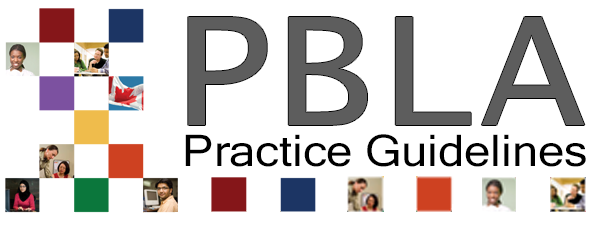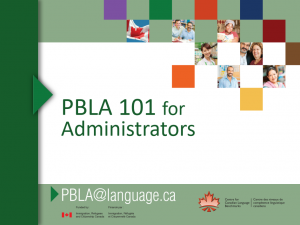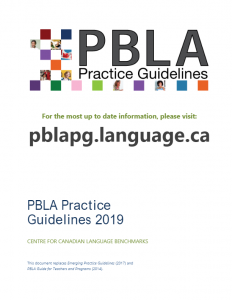PBLA Portfolios – Key Elements
Feedback and Assessment
Feedback and Assessment
In PBLA, the purpose(s) for assessment will affect task design and set up (for example, how much support is provided), as well as the type of feedback that is given. Traditionally the term assessment has been equated with testing at the end of a learning period. However, in PBLA, assessment is equated with ongoing assessment that includes feedback, given in a variety of forms, to move learning forward. For a summary of the principles of assessment foundational to PBLA, see the first section of this document: PBLA Foundations.
Your approach to feedback and assessment will depend on what you want to accomplish. Davison and Leung (2009) suggest a continuum of assessment possibilities that move from very informal, in–the-moment feedback to formal assessment of learning opportunities.
| To view this continuum adapted to a PBLA context see Integrating CLB Assessment (CCLB 2016), Chapter 2, Planning for Assessment. |
In-the-moment feedback (also called assessment for learning): In the classroom, teachers observe performance and provide informal, on the spot feedback – on a variety of classroom activities, everyday. The feedback helps learners move forward (and the observations help teachers adjust instruction). In-the-moment feedback may be
For example, as you monitor group work you may notice a learner effectively using a turn-taking strategy or observe several learners struggling to pronounce a new word. You might give individual feedback immediately or feedback to the whole group after the activity.
Why is in-the-moment feedback valuable? Feedback that is immediate, focused on what the learner is doing or has just done provides in-the-moment information that the learner can use to enhance self-awareness and make changes to improve.
Planned feedback on skill-using tasks (also called assessment for learning): As part of classroom planning, teachers incorporate a range of real-world, skill-using language tasks with CLB-aligned criteria as the focus of learning. These regular classroom activities are designed to provide opportunities for growth and development as learners practise new skills. Teachers use a variety of strategies:
Class time is provided for learners to do something with the feedback (e.g. work with a partner to correct their errors).
Why is planned feedback valuable? To support assessment for learning, opportunities for feedback that move learners forward must be carefully built into the teaching and learning cycle. As Wiggins (2012) notes, “No time to give and use feedback” means “no time to cause learning.”
Formal assessment (also called Assessment of Learning): Other communicative tasks will be designed to allow learners to demonstrate what they can do related to benchmark expectations. These tasks include assessment criteria aligned to the CLB and an indication of what is required for success on the task. Learners complete the tasks independently and the feedback to the learner will indicate whether they have met task expectations in relation to a specific benchmark.
To provide assessment for learning support in the task, teachers also give action-oriented feedback that learners can use to improve their performance.
Why is formal assessment valuable? It provides feedback related to benchmark level expectations (How well am I doing?) and feedback related to learner performance (What do I need to do to improve?).
| For additional information on providing feedback, see Integrating CLB Assessment (CCLB, 2016) Chapter 7, Making Professional Judgments and Providing Feedback, and in the LISTN Instructors’ Bulletin, Action-Oriented Feedback. See also the video Feedback on Learning by Wiliam (nd). |
As you integrate assessment for learning into the teaching/learning cycle, you might notice an increase in the time that you devote to a module. However, for assessment to be most effective in enhancing language learning, it must be a consistent part of the teaching and learning cycle.
Portfolios should contain a balance of skill-using and assessment tasks. Questions about the differences between the two come up frequently; the table below compares key features. Keep in mind that, in practice, you could use a task for one of the two purposes, but would NOT use the identical task as both a skill-using task and an assessment task.
Table 3: Features of Skill-Using and Assessment Tasks, Compared
| Skill-using Task | Assessment Task | |
| Purpose | Opportunity for learners to practise what they have been learning. | Opportunity for learners to demonstrate what they can do in English. |
| Task | A communicative task that relates to a real-world task (RWT). | |
| Alignment to CLB | All activities and tasks should be consistent with CLB expectations (competencies, indicators of ability, profiles of ability, knowledge and strategies). Other criteria may be addressed that are specific to the task and consistent with CLB level expectations.
Criteria selected must be
|
|
| Sharing Criteria with Learners and Assessment Tool | Consistent with assessment for learning strategies, teachers introduce and discuss key criteria with learners before undertaking the task. | |
No formal assessment tool is required.
|
An assessment tool is required for productive tasks but not for receptive tasks.
|
|
| Assessment/Feedback: Productive Skills | Non-evaluative, comments-only feedback is given. Feedback focuses on elements that are particularly important for growth and improvement.
Learners may self-assess and/or receive peer or teacher feedback. Feedback may be written or oral and may be anecdotal. |
Teachers evaluate learner performance of the task and provide action-oriented feedback. Feedback is specific and focuses on how the learner can improve using sentence stems such as For next time … or Please focus on….
In addition, there should be evidence of self-assessment on some (but not necessarily all) assessment tasks. |
| Assessment/Feedback: Receptive Skills | Tasks are ‘marked’ by teacher or learner or a peer.
Self assessment: Learners may reflect on strategies used (e.g., I listened for stressed words to help me understand the key details). |
Tasks are ‘marked’ by teacher or learner.
Self assessment: Learners may reflect on strategies used (e.g., I used the pictures to help me understand the reading). |
| In receptive skill-using and assessment tasks, action-oriented feedback may be included on the task itself. Often the teacher will discuss action-oriented feedback as a class. For example, after a reading task, learners might discuss in small groups where they found the information to answer the inference questions or what information they got from the caption to help them answer the question. | ||


